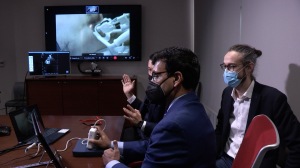by
John R. Fischer, Senior Reporter | April 11, 2022

MELODY robotic tele-cardiac ultrasound system
From the April 2022 issue of HealthCare Business News magazine
In early February, cardiologists at Robert Wood Johnson University Hospital and Rutgers Robert Wood Johnson Medical School in New Jersey performed cardiac ultrasound on a patient in France. Using MELODY, the first FDA-approved clinical robotic tele-cardiac ultrasound solution, designed by AdEchoTech, they were able to assess the patient in real time for several hours, despite an ocean between them.
“What MELODY can do is increase access to ultrasound in remote communities, close to their homes. Patients don't have to travel long ways for appointments. Instead, they and the expert can be present in completely different locations,” Dr. Partho Sengupta, chief of cardiology at Robert Wood Johnson Medical University Hospital, an RWJBarnabas Health Facility, told HCB News.
Telemedicine is just one of many innovations creating new possibilities for cardiac ultrasound, with artificial intelligence and point-of-care solutions paving the way for speedier exams, higher quality care and new types of procedures. Nevertheless, cardiac ultrasound still faces a number of challenges that limit its promise and impede access for patients in need.
Providing care at a distance
Two years ago, Dr. Stephen Little, president-elect of the American Society of Echocardiography and a cardiologist at Houston Methodist Hospital, was prohibited by law from assessing patients outside of Texas remotely. But following the COVID-19 pandemic, regulations were relaxed, and long-distance telehealth became a possibility — almost overnight, he said. “Now, as a healthcare system, we're starting to evaluate post-COVID. Should we be allowed to see a patient via FaceTime or some equivalent software? Should I be permitted to read the echocardiogram that's performed in Wyoming from my office in Texas?”
Hospitals short on staff or who lack specialists can use ultrasound to scan, diagnose and treat cardiac patients faster. This would be especially in rural communities, and also possible outside hospitals and outpatient practices. “Instead of the patients queuing up for a procedure done at an outpatient facility or in hospital, we can provide ultrasound exams in community primary care centers or pharmacies. They can just go to their nearest pharmacy, get their ultrasound exams and will only be required to come to hospital if a more personal procedure is required,” said Sengupta.
He adds that remote ultrasound spares radiologists and cardiologists from radiation exposure in procedures that pair ultrasound with modalities such as X-ray and CT, and helps reduce exposure to COVID-19, which has been linked to heart problems.
